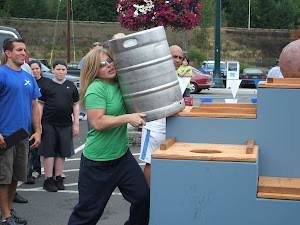When I was in college I spent bored afternoons sitting in the terminal at Logan airport with grounded feet and a soaring imagination. Really I should have been studying for my astronomy class which required extra diligence considering that spectroscopy bored me silly and Dr. Kamal’s incomprehensible Indian accent required a skill of rapid translation that I didn’t possess. In International Departures I was leaving all of that behind me and instead playing Margaret Mead solving mysteries of sociology such as why would any couple purposely wear matching track suits. At this point, if I ever marry, I’ve decided it will be the first Christmas present that I’ll buy my spouse (MY husband would think that was funny which might explain why such a man is so hard to find).
The mysteries just get more interesting as I recently sat next to a gentleman on a flight back to Seattle who managed to combine two classic haircuts – the Mullet and the Caesar – for a look uniquely his own. It’s clear that Caesar wouldn’t have sanctioned that though it had strong potential to scare an enemy. Such a puzzling choice would have dominated all my analytical processes had he not also chosen to wear flip flops with tube socks. The stimulus overload caused my cerebrum to crash into my cerebellum and I had to reboot. I was torn between building the case study and the cost of opening the Pandora’s Box of prattle. If you start chatting to your plane-mate, you have to be prepared to maintain the conversation for the full duration of the flight if he or she decides to keep keeping on. Barring the user-friendly and well-illustrated escape from the well-market exit door, there’s really no place else to go. In the long run, I’d really much rather make an interest-only payment on my ever accumulating sleep debt. This debt has only one useful side effect: when it causes what feels like jet-lag every day of the week, you really don’t feel jet lagged even after you’ve been prattled at cross-continent.
Jet lag is a particular challenge for many people this time of year when the misery of ‘lagging’ is added to the misery of awkward family gatherings that require a heightened readiness to pounce on your own internal edit switch. Thank goodness for Carl Ellison’s trip to Budapest in which he test drove the advice Dr. Singh gave during the talk in September. I’ll let Carl explain:
"Dr. Singh advised me to take 10 mg Melatonin at 4:00 a.m. destination time. I was planning to ease into Budapest time from Pacific over 5 days – maybe 1 or 2 time zones per day – leading up to taking off on Friday morning. I was delayed in that, so I took my first dose of Melatonin on Monday night at 7:00 pm Pacific (4:00 am Budapest). I puttered around and got in bed at about 8:00 pm. At midnight, my eyes were wide open. I was awake and ready to start my day. It never occurred to me that the circadian rhythm reset would happen that fast. So, for the rest of that week, I ran on Budapest time, more or less (lost some sleep in the process – partly from setting an alarm to wake me at 7:00 pm Pacific to take more Melatonin). I believe now (although I haven’t checked with Dr. Singh) that I should have taken only one dose – the day I was flying (or the night before, in this case).
"On the way back from Budapest to Seattle, I did that – took only one dose at 4:00 am Pacific time. I had just boarded the plane in Frankfurt for the leg to Washington Dulles – so I got a glass of water from the flight attendant and took the pills at about 13:00 Frankfurt time. I stayed away long enough to get the meal they served on the airplane – and then put on my eye shades and dozed some from Frankfurt to Dulles. This was max 5 hours of sleep – maybe 4. We changed at Dulles to a flight to Seattle and I didn’t sleep at all on that flight. When we landed in Seattle, it was about 9:30 pm and I felt as I usually do at 9:30 – not really tired but able to go to bed. I got into bed at about 11:00 pm – and had a normal night’s sleep.
"At both ends – Budapest and Seattle (on return) – I had no jet lag. Normally, I have terrible jet lag going East and minor jet lag going West. I’m sold. My thanks to Dr. Singh.”
Don’t try to skip the prep and opt for sleep aids. As this site cautions, ”Some people use sleeping tablets to try to alleviate jet lag. This is a dangerous approach as sleeping pills induce a comatose state with little or no natural body movement, and it is well known that prolonged immobility during flight can lead to fatal blood clots (deep vein thrombosis). This was reported as far back as 1988 in the Lancet, which said it was estimated "that over three years at Heathrow Airport, 18% of the 61 sudden deaths in long distance passengers were caused by clots in the lungs." Picture the leg veins as bags of blood. When this blood doesn't circulate there is a risk that it will clot. In addition, many so-called sleeping pills are variants on anti-histamines and they tend to dehydrate significantly, adding to the already significant problem of in-flight dehydration.”
When I told Dr. Singh about Carl’s results he offered the following, “Thanks for the feedback. I am glad he was able to benefit from the forum. Melatonin is most effective if used under dim light conditions and about 8 hours before the core body temperature minimum. Phototherapy, hypnotics and alertness facilitating agents may also be useful adjuncts. Take care.” Hmmmm, phototherapy, hypnotics – sounds like the same astromony class.
skip to main |
skip to sidebar








A conversation with my clients about exercises, work-outs and nutrition
Search This Blog

About Me
- Heather
- I'm an NSCA-PT and CrossFit certified personal trainer with nine years experience. I hold a purple belt in Brazilian Jiu Jitsu under Marcelo Alonso and Ben Blackstone and I am a Karnataka State Gold Medalist in Weightlifting.

Books
Brain Rules: 12 Principles for Surviving and Thriving at Work, Home, and School Food Politics: How the Food Industry Influences Nutrition, and Health, Revised and Expanded Edition (California Studies in Food and Culture)
Food Politics: How the Food Industry Influences Nutrition, and Health, Revised and Expanded Edition (California Studies in Food and Culture) Good Calories, Bad Calories: Fats, Carbs, and the Controversial Science of Diet and Health (Vintage)
Good Calories, Bad Calories: Fats, Carbs, and the Controversial Science of Diet and Health (Vintage) The Omnivore's Dilemma: A Natural History of Four Meals
The Omnivore's Dilemma: A Natural History of Four Meals Practical Programming for Strength Training
Practical Programming for Strength Training PROTEIN POWER
PROTEIN POWER Secrets of the Soil : New Solutions for Restoring Our Planet
Secrets of the Soil : New Solutions for Restoring Our Planet Starting Strength (2nd edition)
Starting Strength (2nd edition) The Brain Trust Program: A Scientifically Based Three-Part Plan to Improve Memory, Elevate Mood, Enhance Attention, Alleviate Migraine and Menopausal Symptoms, and Boost Mental Energy
The Brain Trust Program: A Scientifically Based Three-Part Plan to Improve Memory, Elevate Mood, Enhance Attention, Alleviate Migraine and Menopausal Symptoms, and Boost Mental Energy Fiber Menace: The Truth About the Leading Role of Fiber in Diet Failure, Constipation, Hemorrhoids, Irritable Bowel Syndrome, Ulcerative Colitis, Crohn's Disease, and Colon Cancer
Fiber Menace: The Truth About the Leading Role of Fiber in Diet Failure, Constipation, Hemorrhoids, Irritable Bowel Syndrome, Ulcerative Colitis, Crohn's Disease, and Colon Cancer The Revolution Will Not Be Microwaved: Inside America's Underground Food Movements
The Revolution Will Not Be Microwaved: Inside America's Underground Food Movements The Zone: A Dietary Road Map to Lose Weight Permanently : Reset Your Genetic Code : Prevent Disease : Achieve Maximum Physical Performance
The Zone: A Dietary Road Map to Lose Weight Permanently : Reset Your Genetic Code : Prevent Disease : Achieve Maximum Physical Performance Twinkie, Deconstructed: My Journey to Discover How the Ingredients Found in Processed Foods Are Grown, Mined (Yes, Mined), and Manipulated into What America Eats
Twinkie, Deconstructed: My Journey to Discover How the Ingredients Found in Processed Foods Are Grown, Mined (Yes, Mined), and Manipulated into What America Eats Mind the Gap: The Science Behind the Sporting Mind
Mind the Gap: The Science Behind the Sporting Mind Extraordinary Knowing: Science, Skepticism, and the Inexplicable Powers of the Human Mind
Extraordinary Knowing: Science, Skepticism, and the Inexplicable Powers of the Human Mind The Subtle Body: An Encyclopedia of Your Energetic Anatomy
The Subtle Body: An Encyclopedia of Your Energetic Anatomy Stumbling on Happiness
Stumbling on Happiness
Products


Resources
- Art DeVany
- Brain Health
- Buy Kettlebells
- CrossFit Eastside
- CrossFit Main Page
- Dr. Cordain's Research
- Dr. Eades
- Dr. Ladd Carlston
- Dr. Randip Singh
- Environmental Working Group
- Food, Farming & Healing Arts
- Get Up! Newsletter
- Health Geek's Wikipedia
- Homework for 10a Class
- Jennifer Adler M.S., C.N.
- Marcelo Alonso BJJ
- Michael Pollan
- O'Lifting Coach Mike Burgener
- Predictably Irrational
- Robb Wolf
- TED: Ideas Worth Spreading
- THIS IS THE PREFERRED MEAL TRACKER
- Tim Ferriss, 4 Hour Work Week


